五步教学法英文教案
小学英语五步教学法教案精品PPT课件 图文
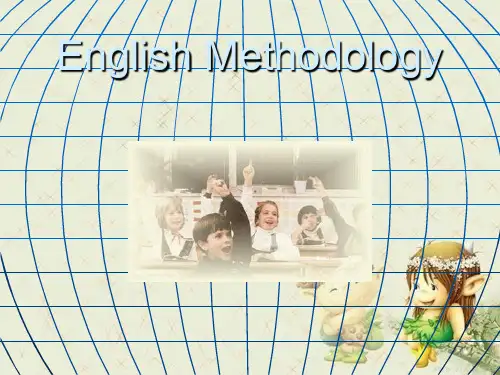
How to train Ss take part in the organization, we should pay attention to the following principles :
教师在组织学生进行操练的时候, 要注意把握以下操练的原则:
1) 针对性原则:
Specific principle: practice should base on the teaching contents and teaching specific targets;
4) 激励性原则:
Incentive principle : praise the Ss all the time and give them confidence; for backward students just ask easier questions, once they get correct answers, we must praise immediately. Encouraging and inspiring students should be remembered all the time.
3) 激发性原则:
Simulative principle: the question should face all Ss; first asking question, then looking for somebody to answer; 提问题的时候要面向全体,先提问,后找人 回答;
Tell the directions east,west,south, north correctly.
Point to the positions of cities correctly.
英语五步教学法

整理复习要点巩固每个单元的语言项目 完成练习册中的练习 写的练习布置家庭作业
总结:
教师在进行上述五个步骤的教学中, 自始至终观察全班学生的反应, 保证所教的内容大家都能理解。如 果相当一部分学生还没有弄懂, 那么教师就需要重教。因此,教师 要随时根据情况变换自己的角色, 起到不同的作用,以保证顺利完成 课堂的整体教学任务。
第五步 巩 固 (Consolidation)
在每节课结束前,要做归纳、总结性练习或检查性复习, 或抄写、拼写或听写以及做练习册中的练习。常常伴有 写的练习,以巩固当堂课所学的内容。每个单元结束前, 进行一次小测验。几个单元结束前,进行阶段性测验, 还有期中、期末复习测验等等,都是为着检验学生学习 的巩固程度,得到教学效果的反馈凭证。 巩固这一教学步骤主要体现在以下几个方面:
第一步 复 习 (Revision)
复习的作用
1“温故知新”,帮助学生回忆所学的语言项目, 强化记忆,并对所学的知识加深理解,总结规律, 发现问题及时加以解决。
2对于练习不够、理解不深透或是疏漏的方面, 及时加以弥补,以便使所学的知识和技能能 更加完善和熟练
第一步 复 习 (Revi、连锁操练等等
第二步 介绍新语言项目(Presentation)
利用黑板、实物、图片、简笔画、 手势动作、录音带或创造情景等等。 还可以用唱歌、朗诵等其它方法创 造情景,介绍新的语言项目
第三步 操 练 (drill)
操练主要是指各种机械形式 的言语训练活动
第四步 练 习 (Practice)
镇江高专教师教育系汤月华
步骤1 (Step 1): 复习 (Revision)
步骤2 (Step 2): 介绍 (Presentation) 步骤3 (Step 3): 操练 (Drill)
高中英语五步教学法
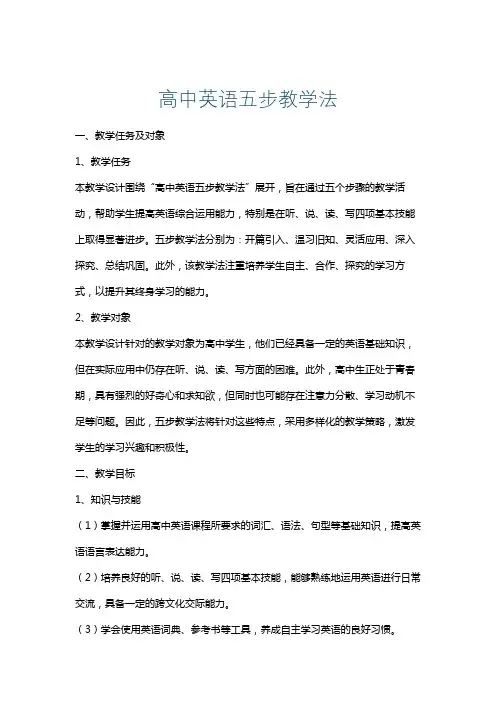
高中英语五步教学法一、教学任务及对象1、教学任务本教学设计围绕“高中英语五步教学法”展开,旨在通过五个步骤的教学活动,帮助学生提高英语综合运用能力,特别是在听、说、读、写四项基本技能上取得显著进步。
五步教学法分别为:开篇引入、温习旧知、灵活应用、深入探究、总结巩固。
此外,该教学法注重培养学生自主、合作、探究的学习方式,以提升其终身学习的能力。
2、教学对象本教学设计针对的教学对象为高中学生,他们已经具备一定的英语基础知识,但在实际应用中仍存在听、说、读、写方面的困难。
此外,高中生正处于青春期,具有强烈的好奇心和求知欲,但同时也可能存在注意力分散、学习动机不足等问题。
因此,五步教学法将针对这些特点,采用多样化的教学策略,激发学生的学习兴趣和积极性。
二、教学目标1、知识与技能(1)掌握并运用高中英语课程所要求的词汇、语法、句型等基础知识,提高英语语言表达能力。
(2)培养良好的听、说、读、写四项基本技能,能够熟练地运用英语进行日常交流,具备一定的跨文化交际能力。
(3)学会使用英语词典、参考书等工具,养成自主学习英语的良好习惯。
(4)掌握一定的英语阅读技巧,如快速阅读、精读、略读等,提高阅读理解能力。
(5)学会用英语进行写作,包括叙述、议论、说明等不同类型的文章。
2、过程与方法(1)通过小组合作、讨论、探究等方式,培养学生的团队合作意识和解决问题的能力。
(2)运用启发式、任务驱动等教学方法,引导学生主动参与教学活动,提高课堂学习效果。
(3)结合多媒体、网络等教学资源,拓展学生的学习渠道,丰富学习内容。
(4)鼓励学生进行课外阅读、参加英语角等活动,提高实际运用英语的能力。
(5)定期进行学习反馈和评价,帮助学生了解自己的学习进度,调整学习方法和策略。
3、情感,态度与价值观(1)激发学生对英语学习的兴趣和热情,树立自信心,形成积极的学习态度。
(2)培养学生的跨文化意识,尊重和理解不同文化背景下的价值观和行为方式。
英语上课流程五步教学法教案
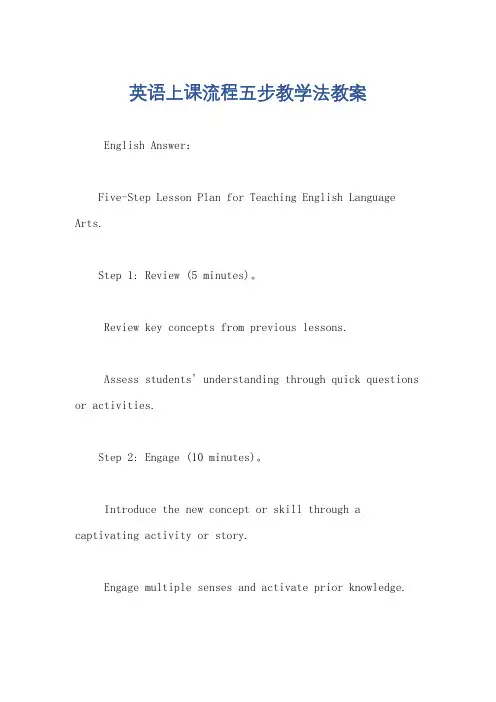
英语上课流程五步教学法教案English Answer:Five-Step Lesson Plan for Teaching English Language Arts.Step 1: Review (5 minutes)。
Review key concepts from previous lessons.Assess students' understanding through quick questions or activities.Step 2: Engage (10 minutes)。
Introduce the new concept or skill through a captivating activity or story.Engage multiple senses and activate prior knowledge.Step 3: Explore (20 minutes)。
Provide students with opportunities to actively explore and interact with the new material.Use hands-on activities, experiments, or discussions to deepen understanding.Step 4: Explain (10 minutes)。
Present the concept or skill explicitly and clearly.Use visual aids, models, or examples to support understanding.Step 5: Elaborate (10 minutes)。
Provide students with opportunities to practice and apply the new skill in different contexts.Encourage students to share their ideas and connect the concept to real-life situations.Assessment.Monitor students' understanding throughout the lesson.Use formative assessments, such as thumbs up/down,exit tickets, or peer feedback, to provide immediate feedback.Conduct summative assessments, such as quizzes or projects, to evaluate overall learning.Differentiation.Provide scaffolded support for students who need additional assistance.Offer enrichment activities for advanced learners.Adjust the pace and difficulty of the lesson to meet the needs of all students.Materials.Visual aids (charts, diagrams, images)。
“五步”英语作文教学法
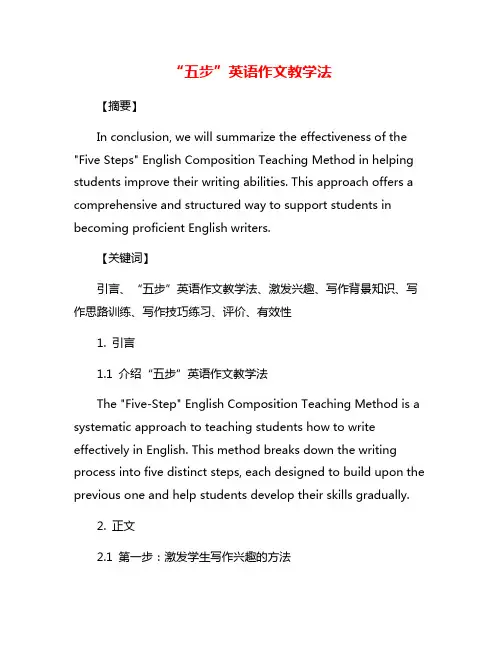
“五步”英语作文教学法【摘要】In conclusion, we will summarize the effectiveness of the "Five Steps" English Composition Teaching Method in helping students improve their writing abilities. This approach offers a comprehensive and structured way to support students in becoming proficient English writers.【关键词】引言、“五步”英语作文教学法、激发兴趣、写作背景知识、写作思路训练、写作技巧练习、评价、有效性1. 引言1.1 介绍“五步”英语作文教学法The "Five-Step" English Composition Teaching Method is a systematic approach to teaching students how to write effectively in English. This method breaks down the writing process into five distinct steps, each designed to build upon the previous one and help students develop their skills gradually.2. 正文2.1 第一步:激发学生写作兴趣的方法Another way to spark students' interest in writing is to incorporate multimedia elements into the writing process. For instance, teachers can show videos, pictures, or listen to music that relates to the writing topic. This can help students visualize and connect with the topic on a deeper level, making the writing experience more enjoyable and meaningful.2.2 第二步:引导学生进行写作背景知识的学习In the second step of the "Five Steps" English essay teaching method, it is crucial to guide students in learning background knowledge for writing. This step involves providing students with the necessary information and context related to the topic they are going to write about.2.3 第三步:组织学生进行写作思路的训练在“五步”英语作文教学法中,组织学生进行写作思路的训练是非常重要的一步。
五步教学法教案范文
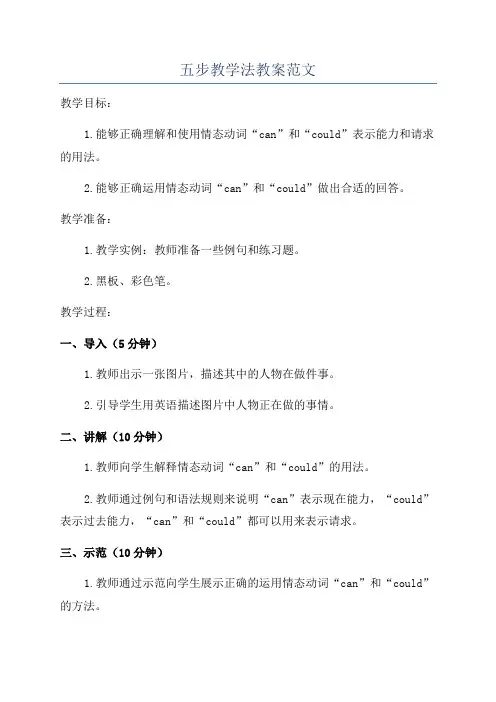
五步教学法教案范文教学目标:1.能够正确理解和使用情态动词“can”和“could”表示能力和请求的用法。
2.能够正确运用情态动词“can”和“could”做出合适的回答。
教学准备:1.教学实例:教师准备一些例句和练习题。
2.黑板、彩色笔。
教学过程:一、导入(5分钟)1.教师出示一张图片,描述其中的人物在做件事。
2.引导学生用英语描述图片中人物正在做的事情。
二、讲解(10分钟)1.教师向学生解释情态动词“can”和“could”的用法。
2.教师通过例句和语法规则来说明“can”表示现在能力,“could”表示过去能力,“can”和“could”都可以用来表示请求。
三、示范(10分钟)1.教师通过示范向学生展示正确的运用情态动词“can”和“could”的方法。
2.教师利用实例句子和画面,模拟各种情境,引导学生运用“can”和“could”进行正确的表达。
四、练习(20分钟)1.教师在黑板上列出几个练习句子,要求学生填写恰当的情态动词。
2.教师让学生两两合作完成练习,然后展示答案并进行讲解。
3.教师提供更多的练习题,让学生在小组内完成。
五、总结(5分钟)1.教师进行总结和回顾,强调情态动词“can”和“could”的用法。
2.教师总结学生在练习中的表现,给予鼓励和认可。
板书设计:情态动词“can”和“could”的用法表示现在能力表示过去能力表示请求举例:I can swim. He could run. Can you pass me the pen?教学反思:五步教学法适用于初中英语教学中的各个语法项目,在本节课中也得到了很好的运用。
导入环节通过图片描述激发了学生的学习兴趣,让学生积极参与到课堂中来。
讲解环节通过语法规则和实例句子的解释,向学生清晰地传达了情态动词“can”和“could”的用法。
示范环节通过情景模拟的方式,让学生在学习中融入实际,更好地理解和运用所学知识。
练习环节则提供了丰富的练习机会,让学生进行实际操作和实践,巩固所学内容。
英语五步教学法
提问的方法,如:连珠炮似的提问、连锁操练等等
第二步 介绍新语言项目(Presentation)
利用黑板、实物、图片、简笔画、 手势动作、录音带或创造情景等等。 还可以用唱歌、朗诵等其它方法创 造情景,介绍新的语言项目
第三步 操 练 (drill)
操练主要是指各种机械形式 的言语训练活动
第四步 练 习 (Practice)
第一步 复 习 (Revision)
复习的作用
1“温故知新”,帮助学生回忆所学的语言项目, 强化记忆,并对所学的知识加深理解,总结规律, 发现问题及时加以解决。
2对于练习不够、理解不深透或是疏漏的方面, 及时加以弥补,以便使所学的知识和技能能 更加完善和熟练
第一步 复 习 (Revision)
复习的方式
整理复习要点巩固每个单元的语言项目 完成练习册中的练习 写的练习布置家庭作业
总结:
教师在进行上述五个步骤的教学中, 自始至终观察全班学生的反应, 保证所教的内容大家都能理解。如 果相当一部分学生还没有弄懂, 那么教师就需要重教。因此,教师 要随时根据情况变换自己的角色, 起到不同的作用,以保证顺利完成 课堂的整体教学任务。
淇滩镇初级中学 任小红
步骤1 (Step 1): 复习 (Revision)
步骤2 (Step 2): 介绍 (Presentation) 步骤3 (Step 3): 操练 (Drill)
步骤4 (Step 4): 练习 (Practice)
步骤5 (Step 5): 巩固 (Consolidadation)
在每节课结束前,要做归纳、总结性练习或检查性复习, 或抄写、拼写或听写以及做练习册中的练习。常常伴有 写的练习,以巩固当堂课所学的内容。每个单元结束前, 进行一次小测验。几个单元结束前,进行阶段性测验, 还有期中、期末复习测验等等,都是为着检验学生学习 的巩固程度,得到教学效果的反馈凭证。 巩固这一教学步骤主要体现在以下几个方面:
小学英语五步教学法
小学英语课堂教学“五步”教学法为推进小学英语课堂教学模式的改革,促使教师掌握课堂教学的基本程序与方法,我们总结了小学英语课堂教学的基本模式——“五步”教学法,即热身复习、新知呈现、趣味操练、巩固拓展、总结作业反馈。
此模式的探索实践旨在为广大小学英语教师的课堂教学指明方向,从而全面提高小学英语课堂教学的质量。
一、热身/复习(Warm - up/ Revision)本环节就是复习巩固已学过的知识,通过师生对话、TPR活动、值日生报告、自我介绍、自由会话等各种形式,复习与新知识有关的旧知识,使学生具备必要的认知前提,保证新知学习的顺利进行;同时也可培养学生的口头表达能力及大胆表现自我的能力。
建议教师要做到以下两点:1、热身活动,目的明确。
也就是说教师所设计的温习旧知识的内容要有目的性,要为本节课或本单元的目标服务。
形式要生动活泼,贴近生活,尤其要紧密结合教材的内容。
2、温故内容,铺垫扎实。
教师不要急于进行新知的学习,温故过程切不可如蜻蜓点水,随意问答几句,要扎实铺垫,为新知的学习奠定良好基础。
主要形式有:Sing songs、Say a poem or chant、TPR、Greetings、Free talk、Play some games(eg.memory test) 根据不同的教学内容,选择不同的热身活动,热身活动的时间长短,可根据学生的学情及教学内容而定。
二、新知呈现(Presentation)这是一节课的主干和重点部分,在这个环节中,教师要采用实物、图片、简笔画、肢体动作等直观教学手段来组织教学,使语言教学直观化、形象化、生动化、趣味化,让学生爱学、乐学、知学、善学。
在讲解新知时教师要注意以下几点:1、突出目标,组织教学。
要求教师在设计每一步教学环节时都要考虑目标,服务目标,力求在有限的时间内直达目标。
2、利用实物,充实教学。
教师要尽可能地体现直观性教学原则,尽可能多地利用实物进行教学。
如在PEP三年级下册教材中,当教到My Family 时,教师和学生都拿出自己的家庭照片当作教具,教师还特意把自家的全家福放大贴到黑板上进行教学,这就很真实、很生活化。
英语五步教学法案例
“五步教学法”示范案例城北中学英语备课组授课人:殷德梅备课组教师:殷德梅胡卫东李德才程旭明王晶梁春爱金爱辉廖仲桥孙琼枝邹德松张桃香赵新莲Unit 3 Project Writing a science fiction story一、教材分析本课是人教版九年级第三单元project部分,要求学生先学习本部分的阅读材料,然后完成书写一篇科幻故事的这个课题。
Project部分的设计是为了提高学生的综合英语素质和能力,以及培养与同学分工合作的能力。
阅读材料是由三本著名的科幻小说内容简介构成,通过对材料的学习,让学生知道科幻故事的基本框架是什么,激发学生的想象力,引导学生去动笔写科幻故事。
Project部分的特色在于它有一个从课内到课外的延伸和拓展,作品的完成在于课外充分准备以及小组成员的配合,它需要学生花时间花精力认认真真地去完成。
在搜集信息和与他人合作的过程中,学生能学到很多,不仅扩充了他们的知识面,也有益于提高他们的自身能力。
二、教学重点和难点本课阅读材料的学习是为了启发学生,然后完成课题。
因此,通过与同学分工合作写出一篇质量较高的科幻故事成为了本课的教学重点和难点。
三、教学目标与要求新英语课程标准中提到:要着重提高学生用英语获取信息、处理信息、分析和解决问题的能力,要使学生在英语学习的过程中,提高独立思考和判断的能力,发展与人沟通和合作的能力,同时帮助学生了解世界和中西方文化的差异,拓展视野,培养爱国主义精神,形成健康的人生观。
那么在本课中,我确立了三个教学目标:一是通过对阅读材料的学习,使学生抓住故事的基本框架,培养学生处理信息的能力;二是通过各种不同形式的讨论,使学生在独立作业的同时又与他人交流获取信息,激发想象力,为科幻故事的撰写提供素材;三是通过国内外科幻的对比,培养学生的爱国情操,积极支持中国科幻片和科幻小说的发展。
再来,把四川汶川大地震和科幻联系起来,通过想象力来提高学生的情商和人文素养。
初中英语课堂“五步教学法”
初中英语课堂“五步教学法”邯郸市第二十五中学英语组【模式流程】互动交流,热身导入——听力练习,初步感知——诵读课文,以读促知——能力提升,学以致用——情感升华,启迪心智【步骤1】互动交流,热身导入通过自由对话、角色表演、歌曲或游戏比赛等形式创设英语环境,以巩固以往教学单元或新近学过的英语话题为主(尽量与新课内容有内在的联系)。
以复习上一节课语言知识点为基础并进行拓展,同时渗透与新课相关的语言信息,并为新课的导入做好铺垫。
在这个过程中,大多数学生都会有机会回答问题、参与表演、游戏或竞赛,教师应以鼓励、表扬为主对学生的应答予以肯定和补充,并同时通过启发性的话语或肢体语言导入新课文中的重点单词和课文话题内容。
【步骤2】听力练习,初步感知通过听力练习帮助学生初步感知文本内容,并通过听力材料的示范,纠正学生的发音。
在听力训练之前,带领学生先有针对性地阅读题目,找出题目中的关键内容,先对听力的整体范围做出一个大致的了解,然后带着问题去听材料,并准备纸笔做好适当记录,从而达到以听促读,以读练听的目的。
【步骤3】诵读课文,以读促知通过“自主默读--感知文本大意;小组合读--互助规范纠正发音;全班齐读—把握文章细节”三种不同的形式,完成对文本内容由浅到深的理解过程。
在读的过程中完成任务型阅读、课文改编的填空练习和课文细节分析和知识能力提升等练习。
不同形式的练习逐步的提高练习的难度和对文章理解的深度,引导学生加深对文章细节的把握和文本意境的分析理解。
本环节学习形式多样,有组内讨论、组间的互问互答、小组展示、老师点拨答疑解惑等。
这些环节的设置遵循学习规律,引导学生逐步深入地掌握知识,实现教学任务。
【步骤4】能力提升,学以致用在学生对语篇有了深入理解之后,教师将教学目标整合并落实到一个或多个具体的活动任务中,借助任务对学生进行能力拓展训练。
可以根据课文内容组织表演、演讲或辩论等活动,让学生在语言实践中体验乐趣、感受成功。
- 1、下载文档前请自行甄别文档内容的完整性,平台不提供额外的编辑、内容补充、找答案等附加服务。
- 2、"仅部分预览"的文档,不可在线预览部分如存在完整性等问题,可反馈申请退款(可完整预览的文档不适用该条件!)。
- 3、如文档侵犯您的权益,请联系客服反馈,我们会尽快为您处理(人工客服工作时间:9:00-18:30)。
五步教学法英文教案:(Period 2 of Lesson 3 Book 2浏览次数:3515 来源:现代教学网加入时间:2005-10-14Teaching Plan (Period 3 of Lesson 3, Book 2)Teaching aims1. Learn the new words “tiger, lion, rabbit, deer”(understanding only).2. Learn the sentence patterns “Is it ...” “Yes, it is. / No, it isn’t.”3. Learn to sing the song “Old MacDonald has a farm”.Teaching aids1. A recorder2. Some pictures of animals3. Hanging charts of let’s talk.Teaching stepsStep 1. Revision1. Revise the names of animals learned before:Show pictures of animals(cat, dog, fox, pig, chick, duck, hen, bee, bird, fish, frog, bear, monkey, panda, elephant, giraffe), and ask Ss to say them.2. Revise the rhyme in Let’s chant: First listen to the recorder. Then ask Ss to repeat and recite the rhyme.3. Revise the dialogue in let’s talk: Put up hanging charts, or show stick drawings of let’s talk. Listen to the tape. Ask Ss to repeat the dialogue of let’s talk. Then ask some students to act it out.Step 2. Presentation1. Learn the new words “tiger, lion, deer, rabbit”:Ask the student to guess some riddles.Example: It’s an animal. It has red eyes and long ears. What is it?Ss may answer in Chinese. Some riddles can also be asked in Chinese.Example: 名字叫小花,喜欢摇尾巴,夜晚睡门口,小偷最怕它。
(Dog)After guessing, ask Ss to take out the handwork materials. Say “Draw a tiger (lion, deer, rabbit)." Get Ss to take out the relative picture and draw it.After drawing all four, say “tiger (lion...)”and get Ss to h old up the relative picture. If possible, show the pictures of tiger(lion...) and ask Ss to say the Chinese meanings.2. Learn the new sentence pattern:First show some pictures. Ask and answer “A cat?” “Yes, it is.”“A dog?” “No, it isn’t.” Then do it again. Ask and answer “Is it a cat?” “Yes, it is.” “Is it a dog?” “No, it isn’t.”Step 3. Drills1. Show pictures of tiger, lion, deer, rabbit and so on. Ask the class “Is ita ..."”Let the class answer “Yes, it is.” or “No, it isn’t”.2. Divide the class into two parts. Let them ask and answer.Example: Teacher show a picture of a tiger and says “deer”. Then let the left half ask “Is it a deer?”.and the right half answer “No, it isn’t.”3. Get the students to practise the dialogue in pairs, using the stick drawings they have drawn.Step 4. PracticePlay a game. Put up (or draw) some pictures of animals on the Bb. Ask Student A to come to the front, facing the class, Students B to come to the Bb. Student B points to one of the pict ures. Student A asks, “Is it a lion ..."” The whole class answer “Yes,it is.” or “No, it isn’t.”Step 5. Learning the songListen to the tape. Then sing after the tape sentence by sentence. After singing several times, sing the whole song.Step 6. ConsolidationRevise the new words and the sentence pattern learned in this period.五步教学法教案:(Period 2 of Lesson 3 Book 1)浏览次数:2228 来源:现代教学网加入时间:2005-10-14Teaching Plan (Period 2 of Lesson 3 Book 1)Teaching aims1. Learn the new words “my, name, is, goodbye, bye.”(understanding and saying them)2. Learn the sentence pattern “my name is ....”3. Learn Part 2 of Let’s talk.4. Learn to chant the rhyme in Let’s chant.Teaching aids1. Flashcards of letters A to G2. Pictures of animals3. Some head ornaments4. A recorderTeaching stepsStep 1. Revision1. Revise the names of the letters A to G:Ask Ss to take out their flashcards of the letters. Say the letters and get Ss to hold up the relative flashcards.Show flashcards of these letters. Get Ss to read them out.2. Revise the names of animals:Ask Ss to take out their pictures of animals. Say the names of animals and get Ss to hold up the relative pictures.Show pictures of animals and get Ss to say the names.3. Revise Part 1 of let’s talk:Go up to some Ss and talk to them like this:T: Hello! I’m ....(or Good morning. I’m....)S: Hello! I’m....T: Nice to meet you.S: Nice to meet you, too.Step 2. Presentation1. Learn the new wor d “name”:Write teacher’s name on the Bb. Point to it and say “my name”. Go up to a student, take up one of his/her books, point to the name on it and say “your name”. Do it several times, and then ask Ss to guess the meaning of “name”. They can answ er in Chinese.2. Learn the sentence pattern “my name is ...."Point to yourself and say “I’m ....” “my name is ....” Then draw stick pictureson the Bb and say, “Look, this is Qiqi and this is Tom.(瞧,这是奇奇,这是汤姆。
)” “They are talking. (他们在谈话) “Now let’s listen. (现在请听他们的谈话。
)”Then act both as Qiqi and as Tom(using finger puppets) and make the follow dialogue:Qiqi: Good morning.Tom: Good morning.Qiqi: I’m Qiqi. My name is Qiqi.Tom: I’m Tom. My name is Tom.Qiqi: Nice to meet you.Tom: Nice too meet you, too.Qiqi: Goodbye.Tom: Bye.Do it several times and then ask Ss to guess the meaning of “my name is ....”.”Goodbye”and “Bye”. They can answer in Chinese.Step 3. Learning Let’s chant1. Play the recorder. Let Ss listen to the rhyme several times.2. Get Ss to chant the rhyme after the recorder.Step 4. Drills1. Play the recorder. Let Ss listen to the dialogue of Part 2 of Let’s talk. Rewind the tape, play again and let Ss repeat it sentence after sentence.2. Divide the whole class into two parts. One half will be Tom, and the other half will be Qiqi. Get Ss to practise the dialogue several times. Then change roles and practise the dialogue again.3. Drill in rows or lines: Let Row 1(or line 1) be Tom, and Row 2 (or Line 2) be Qiqi. Get them to practise the dialogue.4. Drill in pairs: Get Ss to practise the dialogue with their partners. First use their own names. Then take out flashcards of animals and use the names of animals.5. Ask some pairs to stand up and practise the dialogue. They may use their own names, or use the names of animals.Step 5. PracticeAsk some students to come to the front and act out the dialogue. Encourage them to use other words, expressions and sentences they have l earned, such as “Hello” “Good morning? “I’m ...." It’s better to let them put on head ornaments while acting.Step 6. Consolidation1. Revise the names of the letters A to G.2. Learn the dialogue and the rhyme by heart.。
